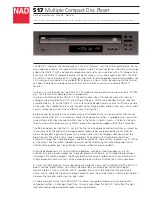
BLU-BD3000 User Manual
14 |
P a g e
Note:
HDMI can transmit both audio and video signals over a single cable. If you have an HDMI
capable receiver that can support HDMI audio, you can simply run an HDMI cable from the
player to your receiver and enable HDMI audio on the receiver (see your receiver’s owners’
manual for more information). The receiver usually has an HDMI output that you can
connect to your TV to pass the video signal.
HDMI is a wonderful thing. A single cable can transport both audio AND video from your
player to your display. Be aware, however, that HDMI is an evolving standard, and there
could be compatibility issues. A receiver that supports audio input over HDMI is required.
Some receivers offer HDMI ports solely for video switching. If your receiver does not have
audio input capability, please read the following sections regarding other connection
methods.
In order to play multi-channel audio for all formats, the receiver must support HDMI v1.1 or
later. For Blu-ray Disc, a receiver that supports HDMI v1.3 with decoding capability for Dolby
TrueHD and DTS-HD Master Audio is preferred. Please check the specifications of your
receiver to ensure that it meets the requirements.
Due to bandwidth limitations, high resolution audio formats such as Dolby Digital Plus,
Dolby TrueHD, DTS-HD High Resolution and DTS-HD Master Audio cannot be sent through
the coaxial digital audio output. A reduced resolution version of the same audio track will be
output instead. To listen to high resolution audio formats in their best quality, please use the
HDMI connection if you have a receiver that handles HDMI audio.
Due to copyright restrictions and bandwidth limitations, full resolution audio from DVDAudio
discs cannot be sent through the coaxial or optical digital audio output. To listen to DVD-
Audio in full resolution, please use the HDMI or analogue audio connections.
Содержание BLU-BD3000
Страница 1: ...BLU BD3000 User Manual 0 P a g e...
















































